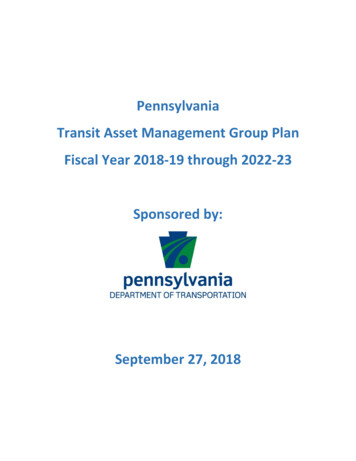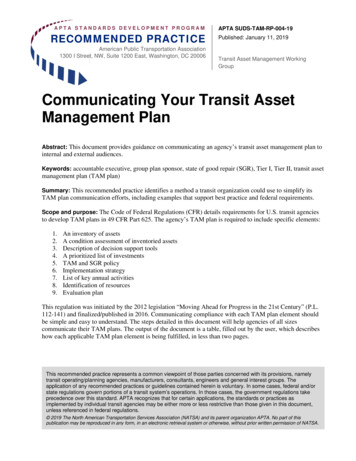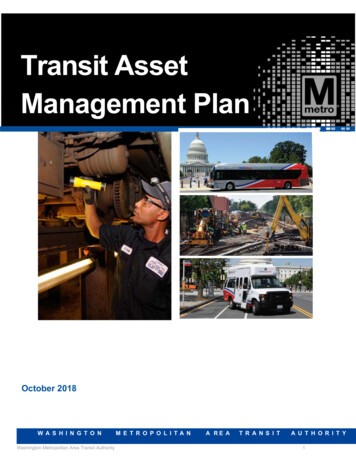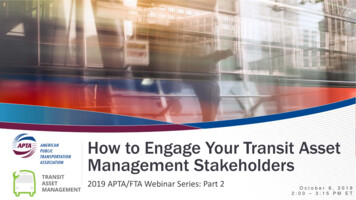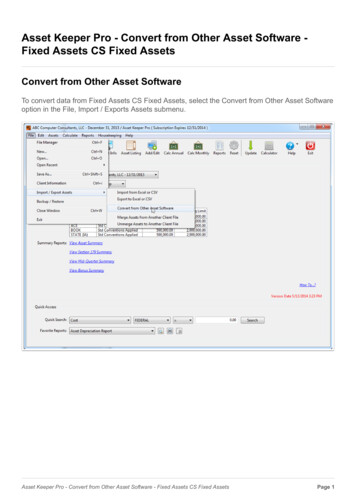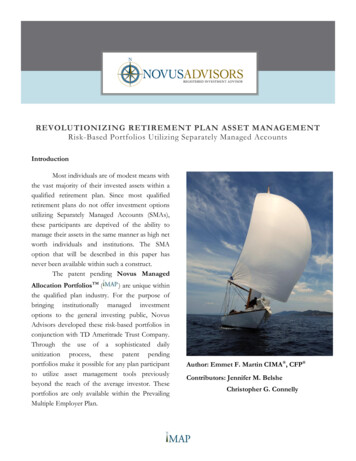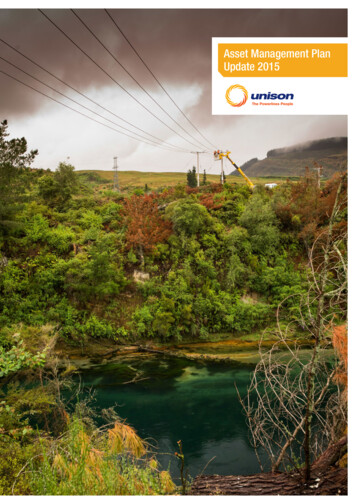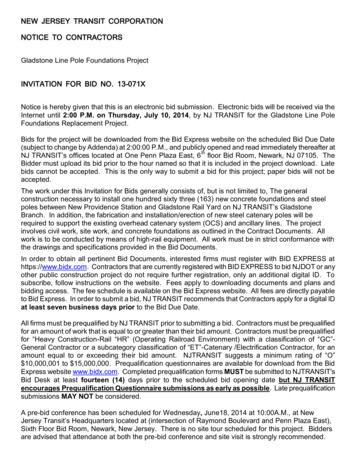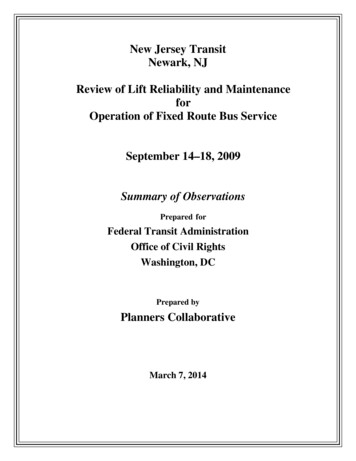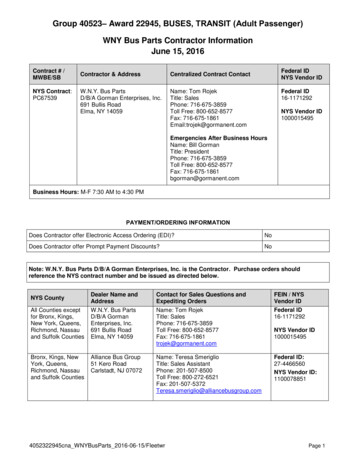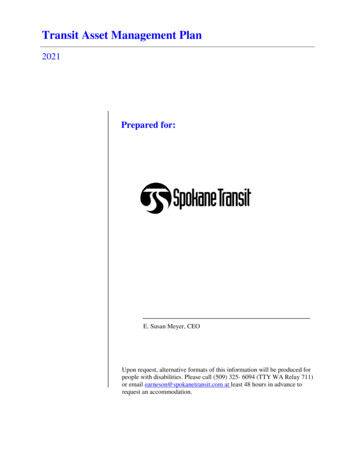
Transcription
Transit Asset Management Plan2021Prepared for:E. Susan Meyer, CEOUpon request, alternative formats of this information will be produced forpeople with disabilities. Please call (509) 325- 6094 (TTY WA Relay 711)or email earneson@spokanetransit.com at least 48 hours in advance torequest an accommodation.
This page intentionally left blank
This page intentionally left blank
Table of ContentsCHAPTER ONE: STA ASSET MANAGEMENT PLAN – POLICYCHAPTER TWO: STA ASSET MANAGEMENT PLAN – TARGETSCHAPTER THREE: STA ASSET MANAGEMENT PLAN – ASSETS & CONDITION ASSESSMENTSECTION 1: ROLLING STOCKSection 1A: Rolling Stock – Fixed Route Vehicle Asset InventorySection 1A: Rolling Stock – Fixed Route Vehicle Decision Support CalculationsSection 1A: Rolling Stock- Fixed Route Vehicle ScorecardSection 1B: Rolling Stock – Demand Response Vehicle Asset InventorySection 1B: Rolling Stock – Demand Response Vehicle Decision Support CalculationsSection 1B: Rolling Stock - Demand Response Vehicle ScorecardSection 1C: Rolling Stock – Vanpool Vehicle Asset InventorySection 1C: Rolling Stock – Vanpool Vehicle Decision Support CalculationsSection 1C: Rolling Stock - Vanpool Vehicle ScorecardSECTION 2: ORGANIZATIONAL EQUIPMENTSection 2A: Organizational Equipment – Support Vehicle Asset InventorySection 2A: Organizational Equipment – Support Vehicle Decision Support CalculationsSection 2A: Organizational Equipment – Support Vehicle ScorecardSection 2B: Organizational Equipment – Owned Equipment – Major Subsystems Asset InventorySection 2B: Organizational Equipment – Owned Equipment – Major Subsystems Decision SupportCalculationsSection 2B: Organizational Equipment – Owned Equipment – Major Subsystems Score CardSection 2C: Organizational Equipment – Owned Equipment – Information Systems Asset InventorySection 2C: Organizational Equipment – Owned Equipment – Information Systems Decision SupportCalculationsSection 2C: Organizational Equipment – Owned Equipment – Information Systems ScoreSECTION 3: FACILITIESSection 3A: Facilities – Owned Facilities Asset InventorySection 3A: Facilities – Owned Facilities Decision Support CalculationsSection 3A: Facilities – Owned Facilities ScorecardCHAPTER FOUR: STA ASSET MANAGEMENT PLAN – INVESTMENT PRIORITIZATION,IMPLEMENTATION STRATEGY, AND IDENTIFICATION OF RESOURCESInvestment Prioritization ProcessImplementation Strategy and Identification of ResourcesCHAPTER FIVE: STA Asset Management Plan – List of Key Activities
This page intentionally left blank
CHAPTER ONE: STA ASSET MANAGEMENT PLAN –POLICYASSET MANAGEMENT AND STATE OF GOOD REPAIR – POLICYSpokane Transit imbeds its asset management and state of good repair policy in the Board-approvedcomprehensive plan, Connect Spokane: A Comprehensive Plan for Public Transportation. Assetmanagement and state of good repair are also reflected in Spokane Transit’s published OrganizationalPriorities and supporting Performance Measures.CONNECT SPOKANE: A COMPREHENSIVE PLAN FOR PUBLICConnect Spokane is the foundation policy document for all facets of Spokane Transit operations. Itcontains fundamental principles, policies, and strategies that are essential to how the organization ismanaged. It also complies with the Washington State requirement under RCW 36.57A.050 for eachpublic transportation entity to develop a comprehensive plan. The Board reviews the document at aminimum of every three years.It is appropriate that the Asset Management and State Of Good Repair Policy is an integrated part of thisimportant document. The entire document is available on STA’s website at the following /comprehensive-plan.Extracts from Connect Spokane that specifically address the policies pertinent to asset management andstate of good repair are reiterated below:Part III: Activities and Programs outlines the following in the section on System Infrastructure:SYSTEM INFRASTRUCTURETransit agencies, including STA, use investments in built infrastructure to provide safe, reliablepublic transportation. As a part of its budget process, STA annually identifies needs for improvementto the system infrastructure. To ensure that these funds are spent responsibly and methodically, thiselement defines how decisions about system infrastructure are made and how projects becomeprioritized. Without following the policies contained within this element, investments in systeminfrastructure become piecemeal and often prove to be wasteful, resulting in losses of both time andfinancial resources.SYSTEM INFRASTRUCTURE GOALInvest responsibly in infrastructure that supports STA’s Mission Statement and statedComprehensive Plan goals and policies.SYSTEM INFRASTRUCTURE PRINCIPLESThese principles are designed to help guide investment priorities and are not intended to note specificprojects or investments, but rather to help decision makers understand the context of systeminfrastructure prioritization within the whole of STA.1. SUPPORTSuccessful infrastructure investments align with the mission, long-term goals, and long- rangeplan of a transit agency.To ensure that infrastructure investments are cost-effective, useful, and efficient, capital projects mustsupport long-term agency objectives. Infrastructure built with the support of the transit agency’scoordinated long-range vision is more likely to succeed than infrastructure built independent fromsystem-wide goals.1
2. OPERATING IMPLICATIONSThe development of system infrastructure has long-term implications for operational functionality.Transit infrastructure projects can range in price and scope. Whether an investment is a large or smallproject, well-planned system infrastructure improvements have long-term implications for operatingcosts and efficiency.3. FISCAL RESPONSIBILITYThe public expects transit agencies to improve its infrastructure in a fiscally responsible manner.Customers and other non-riding taxpayers provide the funding necessary for all of STA’sinfrastructure improvements. Therefore, STA should ensure that infrastructure expenditures are madein a way that reduces waste and maximizes benefit.4. STRATEGIC OPPORTUNISMTransit agencies faced with free or low-cost capital opportunities should consider the long-termoperating expenses to prevent those investments from becoming liabilities.On the surface, any free or inexpensive land/facility offered to the transit agency may seem too good topass up. However, if it is not part of a long-range plan or a strategic opportunity to improve service,seemingly excellent development opportunities can become burdensome investments.Refusing donated/inexpensive capital may seem foolish, but it may prevent those projects frombecoming an unnecessary strain on the transit agency’s network and finances.5. CAPITAL INVESTMENT YIELDSNot every dollar of investment yields the same benefit.Capital investments should be designed to provide the greatest benefit. Cost effectiveness will varyand may not be subject to the same metrics.SYSTEM INFRASTRUCTURE POLICIESSI-1.0 – Capital Investment ConsiderationsUse the following list of considerations to help evaluate the benefits of proposed capital projects.Capital projects are required as a part of an assortment of services which are provided. STA does nothave the resources to complete all of the capital projects identified. However, the following list ofconsiderations help STA evaluate the benefits of each project. These considerations are in addition tothe other policies in this plan. Impact to OperationsConsider the impacts on operational cost, STA staff requirements, speed andreliability of service, and how the project supports the transit network and system. Impact to the Customer ExperienceConsider the impacts on ridership, customer comfort and usability of the system. Value Engineering/ Expected LifetimeConsider options which may increase durability, reduce maintenance needs and addvalue relative to the cost. Also, consider the expected useful life span of the capitalinvestment. Impact to Safety and the EnvironmentConsider the safety, environmental and other impacts related to how the project willimpact the surroundings of employees and customers.2
SI-2.0 – Transit Asset Management PlanIn compliance with state and federal law, STA will maintain an asset management plan certified bythe WSDOT Transportation Commission.The asset management plan will include: An inventory of all transportation system assets as of year-end 2020 A preservation plan based on state of good repairs methodologiesPart III: Activities and Programs outlines the following in the section on Sustainability:SU-1.3 PurchasingPractice a sustainable purchasing policy.The agency should have a holistic decision-making process for purchasing equipment and services. Conduct cost/benefit that considers lifespan costs and replacement strategy. Lower initial capitaloutlays may not be the best value when operations, maintenance, and replacement cycles are alsofactored as costs of ownership. Establish procurement decision process that considers costs involved at each stage of the entirelifecycle of goods purchased, e.g., resource extraction, material processing, product design andmanufacturing, transportation and distribution, purchase and use, and end of life disposal orrecycling. Evaluate the impact of staff resources required to support equipment or new capabilities.3
This page intentionally left blank4
SPOKANE TRANSIT ORGANIZATIONAL PRIORITIES ANDPERFORMANCE MEASURESSpokane Transit formally established five Organizational Priorities. Ensure Safety Earn and Retain the Community’s Trust Provide Outstanding Customer Service Enable Organizational Success Exemplify Financial StewardshipEach of these Priorities is supported by a set of Performance Measures. The Board of Directors reviews,approves, and holds the agency responsible reporting the status of each Performance Measure annually.Three Performance Measures in support of the priority to Exemplify Financial Stewardship are directlyrelevant to STA’s TAM.Financial Capacity / Financial ManagementMeasurement – Adherence to approved Operating BudgetGoal – Operate at, or below, budgeted expendituresMeasured – QuarterlyService Level StabilityMeasurement – Number of years current service level can be sustainedGoal – Minimum 6 yearsMeasured -- AnnuallyAbility to Sustain Essential Capital InvestmentsMeasurement – Fully funded Capital Improvement PlanGoal – 6 yearsMeasured – Annually5
TAM PERSONNEL ROLES AND RESPONSIBILITIESChief Executive OfficerE. Susan MeyerAccountable ExecutiveDirector of Planning &DevelopmentKarl OtterstromReviewerChief Operations OfficerFred NelsonReviewerChief Financial OfficerMonique LiardReviewerPrincipal Transit PlannerKristine WilliamsNTD & Section 5310ComplianceSenior Maint/FacilitiesManagerRalph WilderTAM ManagerSenior Financial ServicesManagerTammy JohnstonInventory AssetVehicle Maintenance Mgr.Todd GriffithFixed Route and NonRevenue VehiclesMaintenance AnalystBrian ConleyTAM Analysis &CompilationFacilities & GroundsManagerDarin HoffmanFacilities & EquipmentSr. Paratransit &Vanpool ManagerJanet StoweDemand Response &Vanpool Vehicles6
Explanation of Personnel RolesCEO (Accountable Executive): As the Accountable Executive of Spokane Transit’s TAM Plan, theCEO is key in working with the rest of the executive team to set asset condition benchmarks to theminimum or beyond FTA requirements for reporting to the State of Washington, FTA and the local MPO.The CEO has the final approval before submission to the MPO (SRTC), State of Washington or FTA.COO (Chief Operations Officer): The COO is responsible for coordinating TAM related informationbetween the Operation’s Personnel and the CEO.DOP (Director of Planning): The Director of Planning coordinates with the Principal Transit Plannersand their staffing to conduct NTD reporting and 5310 requirements.CFO (Chief Financial Officer): The CFO oversees and coordinates with the Financial ServicesManager and other financial staff to ensure the asset inventories are verified through each department andcategorized accordingly.Maintenance/Facilities Manager: The Maintenance/Facilities Manager works with the MaintenanceAnalyst, the F/R Maintenance Manager, the Facilities Manager, and other maintenance administrativestaff as a team to pull all the asset information together for reporting.Principal Transit Planner: This role works with their staff to ensure that NTD reporting and 5310criteria are being met.Financial Services Manager: The Financial Services Manager and staff certify and categorize assets inan official inventory.Maintenance Analyst: The Maintenance Analyst is responsible for collecting asset information from allparties involved to conduct analysis through established methods within the FTA requirements to scoreand report the assets to Spokane Transit for financial and long-term decision making; as well as to theState of Washington, FTA and local MPO.F/R Maintenance Manager: The Fixed Route Maintenance Manager and staff are key in assisting theMaintenance Analyst in identifying and scoring all assets within the F/R Fleet and MaintenanceShops. Aside from Fixed Route vehicles and equipment, this role is also responsible in assisting with allnon-revenue vehicles.Facilities Manager: The Facilities Manager and staffing are key in assisting the Maintenance Analyst inidentifying and scoring all facilities and facility related equipment within Spokane Transit.Paratransit Manager: The Paratransit Manager and staff are key in assisting the Maintenance Analyst inidentifying and scoring all Demand Response and Rideshare vehicles.7
This page intentionally left blank8
SPOKANE TRANSIT TAM TIMELINETimelineActivityAssigned Personnel2020 Q2Begin facilities asset assessments and scoringFacilities Manager,Maintenance Analyst2020 Q4Begin SGR analysis for rolling stockVehicle MaintenanceManager, ParatransitManager, Vanpool Manager,Maintenance AnalystJanuary2021Provide asset inventory lists from theFinance DepartmentSenior Financial Services ManagerJanuary2021Compile draft TAM initiate internal reviewMaintenance Analyst, reviewers,contributors2021 Q1CEO review and approval of the TAMCEO2021 Q1Submit TAM information to NTD, WSDOTPrincipal Transit Planner SeniorFinancial Services ManagerSubmit requests for capital projects for assetreplacement and upgrades consistent withthe TAMSeniorFacilities/MaintenanceManagerInclude TAM as an appendix to theTransit Development Plan as approved bythe STA Board of DirectorsPrincipal Transit PlannerDirector of Planning andDevelopmentTransmit updated TAM to MPO and WSDOTPrincipal Transit Planner2021 Q1July 2021August 20219
This page intentionally left blank10
CHAPTER TWO: STA ASSET MANAGEMENT PLAN –TARGETSASSET MANAGEMENT AND STATE OF GOOD REPAIR – TARGETSIn January 2017, Spokane Transit’s CEO established Initial Asset Management Targets and forwardedthose goals to Spokane Regional Transportation Council (SRTC). SRTC is our Metropolitan PlanningOrganization (MPO). These targets were modified slightly in January 2018 to better reflect STA’sassessment methodology and have been forwarded to the SRTC. In February of 2020, there was a smallchange to the Rideshare ULB targets to better represent the current needs of the program.Spokane Transit uses two measurement concepts to set these targets.All vehicle targets, whether categorized under Equipment or Rolling Stock use four criteria: 1. UsefulLife Benchmark (ULB) based on age; 2. ULB based on mileage; 3. safety condition assessment; and 4. afinancial level of maintenance calculation.All other Equipment and Facilities targets are determined using Federal Transit Administration TransitEconomic Requirements Model (TERM) scale.A verbatim copy of the SGR targets that STA filed with our MPO is included on the following pages.11
This page intentionally left blank12
Spokane Transit AuthorityTransit Asset Management PlanState of Good RepairAsset Management TargetsThe Chief Executive Officer has approved the Asset Management Targets to satisfy the FTA’srequirement to set SGR targets.E. Susan MeyerDateChief Executive OfficerTo satisfy the requirements in FTA Final Rule 49 CFR Parts 625 and 630, the State of Good Repair AssetManagement Targets for Spokane Transit Authority is stated below.13
This page intentionally left blank14
STATE OF GOOD REPAIR (SGR) VEHICLE CONDITION GUIDELINESEQUIPMENTSUPPORT or NON-REVENUE VEHICLESMaintain the Support or Non-Revenue Vehicles to a degree that greater than or equal to ninetypercent (90%) of these vehicles meet STA’s SGR standard.State of Good Repair standard is determined through an analysis of the following criteria:1). Vehicle Useful Life Benchmark (ULB): Support or Non-Revenue vehicles will have an open servicelife (see Vehicle Mileage(ULB)).2). Vehicle Mileage (ULB): Mileage for General Service (Supervisor, Security, and Transportation)vehicles will have a service life of 200,000 miles. Facilities and Grounds service vehicles will have aservice life of 150,000 miles. Fixed Route and Paratransit Maintenance Shop trucks (wreckers andmaintenance service trucks) will have a service life of 100,000 miles.3). Meets Financial Needs of SGR: Vehicle historical maintenance data indicates the maintenance cost(parts and labor) for a vehicle in an open service life will equal approximately 50% of its purchaseprice. A vehicle performing within these criteria will meet the financial needs of an SGR.4). Is the vehicle safe: STA is committed to providing safe public transportation services to the Spokaneregion and emphasizes safety of our customers and employees in all aspects of operations. Only safeoperational vehicles are committed for public and employee transportation services. VehiclePreventive Maintenance (PM) inspection intervals are monitored to ensure current inspections arecompleted and that our vehicles remain safe to operate.TECHNOLOGY and SUPPORT EQUIPMENTThe condition of STA’s technology and support equipment will be evaluated in accordance with theFederal Transit Agency’s Transit Economic Requirements Model (TERM). STA will maintain thetechnology and support equipment (office management systems, CAD/AVL dispatch systems, etc.) suchthat greater than or equal to ninety percent (90%) of the technology and support equipment have a TERMcondition rating of “3” (adequate) or better.ROLLING STOCKBUSESMaintain the bus fleet to a degree that greater than or equal to ninety percent (90%) of these vehicles meetSTA’s SGR standard.State of Good Repair standard is determined through an analysis of the following criteria:1). Vehicle Useful Life Benchmark (ULB): Buses will experience a 15 and 20 (30’ hybrids) yearservice life.2). Vehicle Mileage (ULB): The medium-size 30’ bus will experience a 20 year /350,000-mile servicelife. The 35’, 40’ and 60’ buses will experience a 15 year /750,000-mile service life.3). Meets Financial Needs of SGR: Bus historical maintenance data indicates the maintenance cost(parts and labor) for a vehicle in its 15-year service life will equal approximately 80% of its purchaseprice. A vehicle performing within these criteria will meet the financial needs of an SGR.4). Is the vehicle safe: STA is committed to providing safe public transportation services to the Spokaneregion and emphasizes safety of our customers and employees in all aspects of our operations. Onlysafe operational vehicles are committed for public and employee transportation services. VehiclePreventive Maintenance (PM) inspection intervals are monitored to ensure current inspections arecompleted and that our vehicles remain safe to operate.15
PARATRANSIT VANSMaintain the Paratransit Van fleet to a degree that greater than or equal to ninety percent (90%) of thevehicles meet STA’s SGR standard.State of Good Repair standard is determined through an analysis of the following criteria:1). Vehicle Useful Life B
approves, and holds the agency responsible reporting the status of each Performance Measure annually. Three Performance Measures in support of the prior ity to Exemplify Financial Stewardship are directly relevant to STA’s TAM. Financial Capacity / Financial Management . Me
